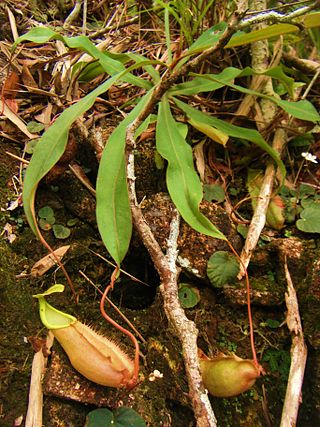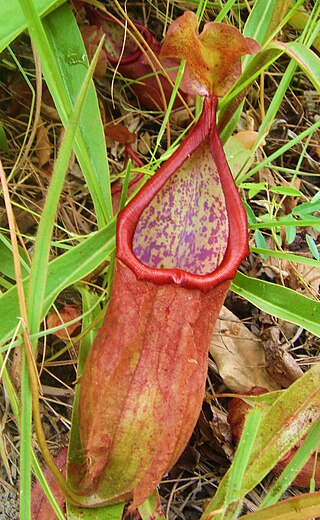
Hoya is a genus of over 500 accepted species of tropical plants in the dogbane family, Apocynaceae. Most are native to several countries of Asia such as the Philippines, India, Thailand, Malaysia, Vietnam, Bangladesh, Indonesia, Polynesia, New Guinea, and many species are also found in Australia.

Afgekia is a small genus of large perennial climbing shrubs native to Thailand in Asia, belonging to the family Fabaceae. They are reminiscent of the related genus Wisteria.

Dendrobium crumenatum, commonly called pigeon orchid, or 木石斛 is an epiphytic orchid in the family Orchidaceae and is native to Asia, Southeast Asia, New Guinea and Christmas Island. It has two rows on leaves along its pseudobulb and relatively large but short-lived, strongly scented white flowers. It usually grows in exposed positions in lowland rainforest and coastal scrub.

Nepenthes benstonei is a tropical pitcher plant endemic to Peninsular Malaysia, where it grows at elevations of 150–1350 m above sea level. The specific epithet benstonei honours botanist Benjamin Clemens Stone, who was one of the first to collect the species.

Nepenthes kerrii is a tropical pitcher plant native to Tarutao National Marine Park in southern Thailand, where it grows at elevations of 400–500 m above sea level. The 2018 IUCN assessment also considers the taxon found on Langkawi Island of Malaysia to be conspecific. This species is thought to be most closely related to N. kongkandana.
Arthur Francis George Kerr (1877–1942) was an Irish medical doctor. He is known particularly now for his botanical work, which was important for the study of the flora of Thailand.

Nepenthes andamana is a tropical pitcher plant endemic to Phang Nga Province, Thailand, where it grows near sea level in coastal savannah and grassland. It is thought to be most closely related to N. suratensis.

Nepenthes chang is a tropical pitcher plant endemic to the Banthad Mountains of central Thailand, where it grows at elevations of 300–600 m above sea level. It is thought to be most closely related to N. kampotiana.

Nepenthes suratensis is a tropical pitcher plant endemic to Surat Thani Province, Thailand, where it grows near sea level in coastal savannah and grassland. It is thought to be most closely related to N. andamana.

Hoya kerrii, also referred to colloquially as Hoya hearts, is a species of Hoya native to the south-east of Asia. Its eponymous collector is Arthur Francis George Kerr, Irish physician and botanist.
William Grant Craib was a British botanist. Craib was Regius Professor of Botany at Aberdeen University and later worked at the Royal Botanic Gardens, Kew.

Elian Emily Collins was an English botanist, naturalist and an early collector of plant specimens in Thailand. She discovered several plant species new to science and had numerous species named after her.
Quercus kerrii is an uncommon Asian species of tree in the family Fagaceae. It is native to Thailand and Vietnam. There are also populations in southern China that according to some authors belong to Q. kerrii but considered by others to belong to a different species, Q. helferiana.Quercus kerrii is placed in subgenus Cerris, section Cyclobalanopsis.

Pachycentria glauca is a small epiphytic shrub in the Melastomataceae family. It has 2 subspecies: P. glauca subsp. glauca and P. glauca subsp. maingayi. The glauca subspecies is endemic to Borneo, the maingayi subspecies is native to Peninsular Malaysia and Thailand, perhaps Sumatra. It grows on trees, other epiphytes and rocks in partial shade. It is intimately associated with particular ant species, growing on their gardens, providing a home for them, feeding them and having its seeds dispersed by them.

Goniothalamus calvicarpus is a species of plant in the family Annonaceae. It is native to China, Laos and Thailand. William Grant Craib, the British botanist who first formally described the species, named it after its hairless fruit.
Goniothalamus expansus is a species of plant in the family Annonaceae. It is native to Thailand and Vietnam. William Grant Craib, the British botanist who first formally described the species, named it after its expanded stigmas.

Hoya bilobata, commonly known as wax plant or porcelain flower, is a smaller species of the genus Hoya native to the Philippines. Hoya bilobata is just one of over 200 species of the genus Hoya.

Mitrephora winitii is a species of plant in the family Annonaceae. It is native to Myanmar and Thailand. William Grant Craib, the British botanist who first formally described the species, named it after Phya Winit Wanandor, the Thai botanist who collected the specimen that Craib examined. In the Prachuap Khiri Khan province of Thailand it is commonly referred to as Mahaphrom.
Pseuduvaria trimera is a species of plant in the family Annonaceae. It is native to China, Myanmar, Thailand, and Vietnam. William Grant Craib, the British botanist who first formally described the species, named it after its fascicles of flowers that often occur in three parts.
Sigmoidala is a monotypic genus of flowering plants in the family Fabaceae, first established in 2019. Its only species is Sigmoidala kityana, native to Myanmar, northern Thailand and Laos. It was first described by William Grant Craib in 1927 as Millettia kityana.














